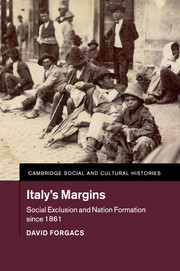
- Publisher:
- Cambridge University Press
- Online publication date:
- April 2014
- Print publication year:
- 2014
- Online ISBN:
- 9781107280441

Italy's Margins explores how certain places and social groups in Italy have been defined as marginal or peripheral since unification. This marginalization involves not only concrete policies but also ways of perceiving people and places as outside society's centre. The author looks closely at how photography and writing have supported political and social exclusion and, conversely, how they have been enlisted to challenge it. Five cases are examined: the peripheries of Italy's major cities after unification; its East African colonies in the 1930s; the less developed areas of its south in the 1950s; its psychiatric hospitals before the reforms of the late 1970s; and its 'nomad camps' after 2000. Each chapter takes its lead from a symptomatic photograph and is followed by other pictures and extracts from written texts. These allow the reader to examine how social marginalization is discursively performed by cultural products.
Winner of the 2014 American Association for Italian Studies Book Prize, Twentieth and Twenty-First Century Category
‘This is a highly original and beautifully written book. The author takes as his subject matter the ways that marginal people and places have been represented and understood by photographers, filmmakers, writers and others in Italy since unification. His understanding of the creation of these ‘margins’ is linked to the formation of the Italian nation-state. Multidisciplinary, wide-ranging, constantly surprising and always incisive, Italy’s Margins is a path-breaking piece of work.’
John Foot - University of Bristol
‘Meticulously researched and yet highly readable … Drawing upon a richly comparative background, David Forgacs turns his discerning eye to the ideological work done by photography in determining ways of looking that constitute marginality as such. The result will change our way of looking at the history of modern Italy itself.’
Barbara Spackman - University of California, Berkeley
‘This is a brilliant book. Through the analysis of photographs and written texts, David Forgacs explains how the Italian nation has been built on the process of social and symbolic exclusion and, in so doing, he offers us an original and fascinating new perspective on modern Italian history.’
Lucy Riall - European University Institute, Florence
‘Italy's Margins is a landmark achievement. Drawing on compelling arrays of photographic and written material, Forgacs surveys post-Unification Italy's web of ‘other spaces’: its urban peripheries and colonies, its ‘souths’, asylums and migrant encampments. His dense cartography of these marginal social spaces, their sites of exclusion and resistance, captures with exceptional force their role as hidden matrices of Italy's modernity.’
Robert S. C. Gordon - University of Cambridge
'Italy's Margins offers an extremely original, well-researched, and detailed analysis that raises key questions on the construction of national identity and of marginality, and sheds new light on a number of different fields, engaging the reader through a compelling argument and highly readable prose.'
Marina Spunta Source: H-Net
'Forgacs’s very impressive book offers a stimulating multidisciplinary account of modern developments in Italian history that should be required reading for any scholar working on marginality, no matter the national context. The book exposes the relations of power that preside over dynamics of exclusion and, more importantly, makes us aware of our own contradictory role in these dynamics: every time we speak in the name of the excluded we reaffirm our own privileged position as researchers, even as we try to counteract the structural imbalance in the scale of power.'
Simonetta Falasca-Zamponi Source: American Historical Review
'An innovative scholar of twentieth-century Italian culture and a major scholar of Antonio Gramsci, Forgacs is known for studies that have questioned the conventional periodization of modern Italian history by showing cultural continuities between the fascist regime and the democratic Republic. Here too he often moves across conventional space-time compartmentalizations to dissect the ways in which Italian culture and nation formation have produced exclusion and social marginality, creating spaces that belong in the nation and yet are placed outside of it: from urban peripheries, to the colonies, the south, insane asylums, and 'nomad' camps … Forgacs’s critical analyses of counterrepresentations offer indispensable tools for those who are involved in the work of cultural critique.'
Silvana Patriarca Source: The Journal of Modern History
 Loading metrics...
Loading metrics...
* Views captured on Cambridge Core between #date#. This data will be updated every 24 hours.
Usage data cannot currently be displayed.